Thessaloniki is an open Museum of Early Christian and Byzantine Art. In 1988 the UNESCO declared World Heritage Sites 15 of the 'finest monuments' of the city, representative samples of this period of its history. The Walls of Thessaloniki, the churches, monasteries and Byzantine baths, included in the UNESCO list, all creations of unique architecture and rare religious art, considered that have such and so high cultural importance, that it is necessary to be preserved in the historical memory of the entire humanity. We summoned up these monuments in the thematic 'UNESCO Monuments Route' to include them into your own list!
Church of Aghios Dimitrios
Dedicated to the patron Saint of the city, the majestic church of Aghios Dimitrios is one of the holiest pilgrimage churches of Christendom and the most important early Christian Church of Thessaloniki. It was built on the ruins of a Roman bath complex, the place where was imprisoned and martyred the Saint in 303 AD.
The holy place of martyrdom, the Crypt, located beneath the transept of the church and in the late Byzantine years was the center of the Saint’s miraculous myrrh production. The miraculous myrrh gushing from the grave (that's why the Saint's nickname is Myrovlytis) and his reputation as a protector that protected Thessaloniki by the relevant invaders with His Divine intervention, overcame geographical boundaries of the city, and millions of pilgrims around the world who come to honor his grave for seventeen centuries.
The first church of Aghios Dimitrios was built after 313 AD. In 1493 it was converted into a mosque. After the liberation of the city in 1912 re-opened, but in 1917 the temple was almost destroyed by the great fire that burned the biggest part of the historical center of Thessaloniki. The church in its current form is a five-aisled basilica with narthex and transept, characterized by rich painting, mosaic and marble decorations, while in the southeast corner is annexed the chapel of Ag. Efthymiou.
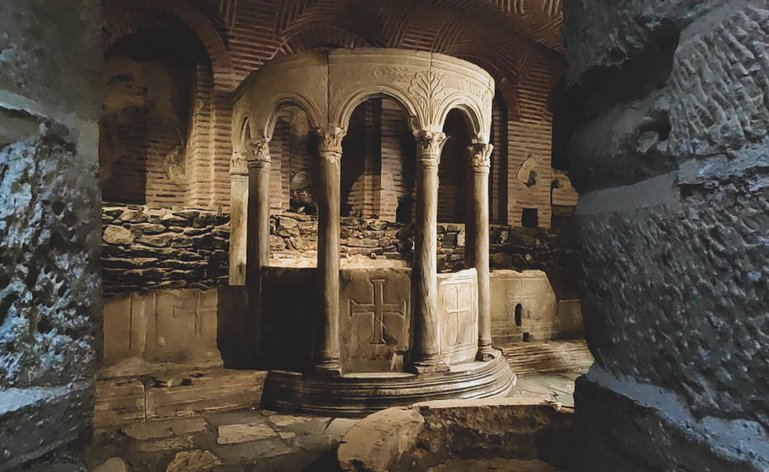
Church of Aghios Dimitrios
Rotunda
The Rotunda is one of the most imposing monuments of Thessaloniki and one of the most important of the Roman period in Europe. With its architectural power and the unrivaled art internal mural mosaics, constitutes a special monument, unique balancing between the pagan and the Christian world. It was founded in the early 4th AD century, probably as a temple of the ancient worship or mausoleum of Constantine (306-337) located on the axis of the processional route, which connected the triumphal arch of Galerius with the palace complex, near the present Navarinou Square. The circular and dome roofed emblematic monument has a height of 29.80 m., diameter 24.50 m., width of walls 6.30 m.
Architectural can only be compared to the Pantheon in Rome. Shortly after its construction, it was converted into a Christian church dedicated to the Aghioi Asomatoi or the Archangels. It was Metropolis of Thessaloniki from 1524 to 1591, when it was converted into a mosque by the Ottoman conquerors until the liberation of Thessaloniki in 1912. The dedication of the monument to Saint George is due to the neighboring, small, homonymous church. Today the Rotunda, with history of more than 1700 years, is at once church and cultural - archaeological monument, in which the tourist visiting, the ecclesiastical liturgy and hosting cultural events are all combined, matching the monument's character and history.
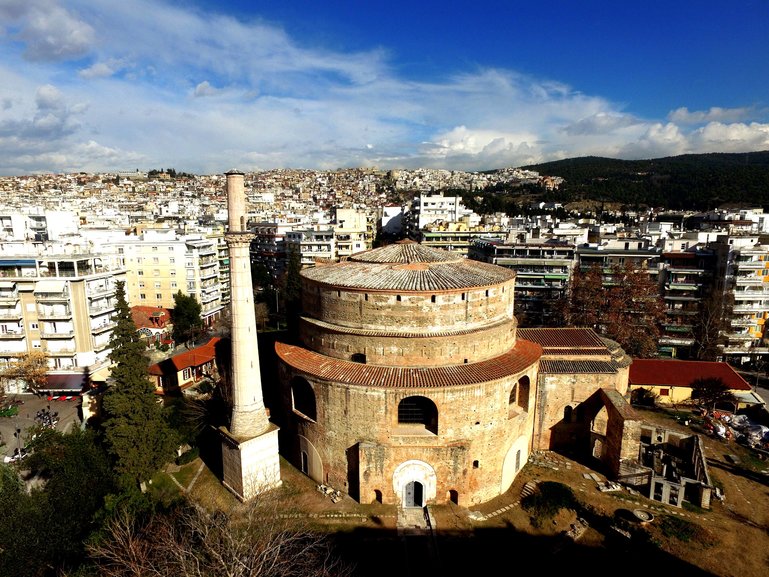
Rotunda
Church of Aghia Sophia
Almost untouched in time, the Church of Aghia Sophia, dedicated to Christ, the true Word and Wisdom of God, Aghia Sophia constitutes for centuries spiritual beacon for Thessaloniki. It was built in the late 7th century and is a typical sample of transitional cruciform church with a dome and an ambulatory, in imitation of the Hagia Sophia in Constantinople. The beautiful mosaics, the 11th century wall paintings and its sculptural decoration are considered masterpieces of religious art. During the Latin occupation in Thessaloniki (1204-1224) the church became a cathedral of the Latins and after the restoration of Byzantine domination of the city formed again the Orthodox Bishop of Thessaloniki until 1523/24, on Maktoul Ibrahim Pasha, when it was converted into mosque.
Church of the Acheiropoietos
The impressive church of the Acheiropoietos owes its name to the worshipful icon of the Virgin Mary, which according to tradition is not painted by human hand ('Acheiropoietos' meaning 'made not by human hands'). The Church of the Acheiropoietos, the Church of Aghios Dimitrios and Aghia Sophia are the most characteristic examples of early Christian churches. The mosaics, murals, the ornamentation and the portable icons in the Acheiropoietos Church are a veritable treasury of sacred art. It was built as a three-aisled wooden-roofed basilica with a narthex and gallery over the ruins of a Roman bath complex. The Acheiropoietos is the first Christian church converted into a mosque immediately after the fall of Thessaloniki in 1430 by the sultan, who indeed, to commemorate his victory, ordered to be engraved on one of the marble columns the phrase:
"The Sultan Murad conquered the city of Thessaloniki in 833" (= 1430), which is preserved to this day.
Church of Aghia Ekaterini
The church is dated in late 13th-early 14th century and was served as katholikon (main church) to a Byzantine monastery. Distinguished by its ornate external masonry and internal murals with themes from the Gospel, the miracles of Jesus, etc., which were plastered by the Turks when the church was converted into a mosque. The hagiographies (frescoes) followed by the Macedonian school of iconography, where the human body is shown strong and robust, have the strength to captivate the hearts of visitors with their power and intensity.
Church of Panayia Chalkeon
The bright red color of the bricks on the outside of the church is the characteristic feature which gave to the Church the popular nickname 'Red Church'. This church was built in 1028 by Christophoros Protospatharios, Katepano (Governor) of Lagouvardia, his wife Maria and his children Nikiphoros, Anna and Katakali. It follows the classic Byzantine style, with four columns and three domes. It belongs to the "Macedonian Period" of Byzantine architecture and its location near the neighborhood of the coppersmiths gave to the church its name (Panayia Chalkeon).
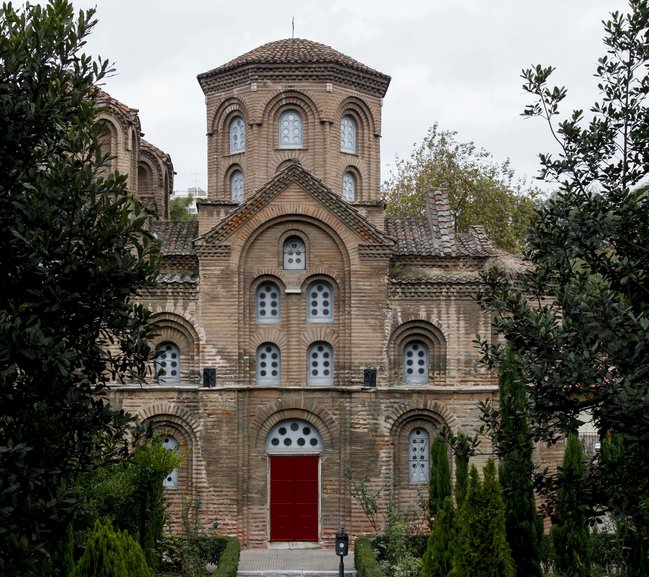
Church of Panayia Chalkeon
Church of Aghioi Apostoloi
It was built by the Patriarch Nephon I as a katholikon (main church) of a monastery in 1310. During the Ottoman period it was turned into a mosque and the murals were covered up once the gold leaf had been removed. Masterly mosaics of the era of Nephon are fragmentarily saved to the highest points of the main church: Τhe Pantocrator and the prophets on the dome, the Εvangelists in the pendentives, the Twelve Great Feasts in the arches and western wall and holy martyrs. The iconographic program of the church filled with high artistic quality murals with scenes from the Old and New Testament and with symbolic themes or inspired by hymnography.
Church of Aghios Nikolaos Orphanos
A small treasure of religious art is hidden at the Church of Aghios Nikolaos Orphanos, which was constructed in the early 14th century as the catholicon of a byzantine monastery, with brilliant internal decorations, which are among the most well preserved painted sets of Thessaloniki. Wonderful samples of Paleologan art are displayed, such as scenes of the functional circle, the Passion and Miracles of Christ, various saints and the life of Aghios Nikolaos. The church garden is an oasis of peace and tranquility from the city’s noise.
Church of Aghios Panteleimon
Close to Rotunda and Galerius’ Arch (Kamara), you can find the church of Aghios Panteleimon, a spiritual center in the 14th century, a place where the remarkable Hellenists Thomas Magistros and Matheos Vlastaris used to write and teach. Built in the late 13th century as the catholicon of Panagia Perivleptou Monastery, also known as Mr. Isaac’s Monastery named by its founder, Jacob, the bishop of Thessaloniki, thereafter monk Isaac. In the mid 16th century, the church was turned into a mosque, whose minaret base is still preserved.
Between the churches of Panagia Gorgoepikoou and Ypapantis, you can find the small church of Metamorphosis tou Sotiros with great architectural interest as the rate is that of the registered Tetraconch while its construction is dated around 1350. The frescoes of the church dated the period 1350-1370 and form part of Palaiologan tradition.
Church of Profitis Elias
Built over a natural mound, this 14th century church, once dominated the city. It displays a unique representation of the athonic architectural type, with a fine dome and ceramic decorations which affected the Serbian mastery afterwards. The most distinguished of all, is the depiction of the Infanticide, classic sample of the final phase of the paleologan painting.
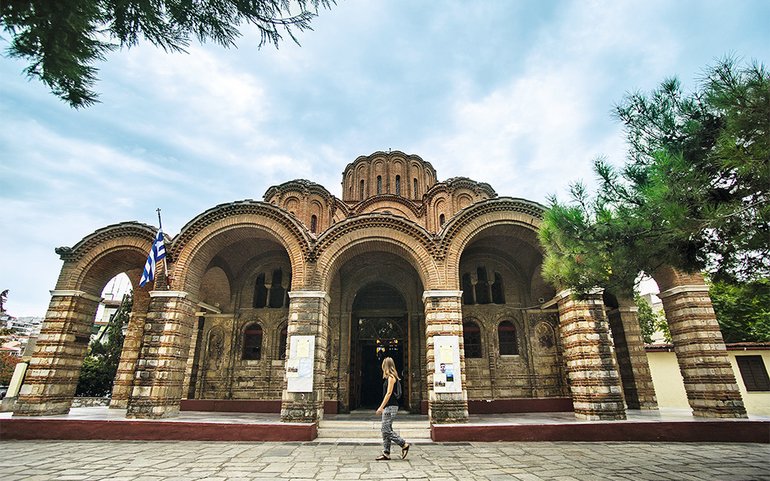
Church of Profitis Elias
Church of Osios David (Latomou Monastery)
The old catholicon of the Latomou Monastery, named after the nearby stone quarry, is a late 5th century church, dedicated to Osios David. It is famous for its unique worldwide mosaic on the temple’s alcove, a depiction of Ezekiel’s vision of Christ at a young age, encircled by the symbols of the four Evangelists, with Avakum and Ezekiel on the sides.
Vlatadon Monastery
A monastery of great importance since is the only byzantine monastery in the city, operating up until today. According to the tradition, it was built at the exact spot where Apostle Paul taught during his stay in Thessaloniki. It was founded in 1351-1371 by the monk Dorotheos Vlatis, pupil of Gregorius Palamas and subsequently Bishop of Thessaloniki. It currently houses the headquarters of the patriarchal Institute of Paternal Studies of the Ecumenical Patriarchate of Constantinople. Furthermore, the monastery is quite famous for another reason far beyond of any religious aspect, it offers an exceptional view to the city, as far as Olympus mountain, while the sunset over the Thermaikos Gulf is definitely something to remember.
Byzantine Baths
It is the only public bath of the Mid-Byzantine era still preserved until today in Greece, and one of the few remaining secular buildings of that particular era. Its erection commenced in 1300 BC and fully functioned until 1940, for approximately seven centuries, and this is the reason that this monument is considered a “living” part of the city’s social history.
The Walls
Since the day of its foundation, Thessaloniki was surrounded by Walls, fortification constructions for the city’s defense and protection, by possible invaders. The major parts of the fortifications were constructed during the reign of emperor Theodosius the Great (late 4th century). The total perimeter of the walls is 8 kilometers, while its present form is due to Ottoman intervention. Don’t miss the chance to meet Thessaloniki of the Walls. In this beautiful area, known as Kastra (Walls), a different city co-exists, made of old and traditional neighborhoods, particularly lovable both to the visitors and the residents of Thessaloniki, for the amazing sunset and the extraordinary view of the city from above.
Heptapyrgion
Heptapyrgion, also known as “Yendi Koule”, on the North-East far end of the Acropolis, is one of the Balkans’ most emblematic fortification complexes, which was reinforced and implemented since paleochristian – early byzantine era, up to the years of Ottoman occupation. Due to its seven (hepta) towers, in its initial form, it was given the name “Heptapyrgion”. In the 19th century it operated as a prison, with new buildings being added to the complex to improve its functionality. This prison was shut down in 1989 and was given to the Greek Ministry of Culture.
Acropolis Walls –Anna Paleologina Gate – Trigonion Tower or Alysseos Tower
Ascending towards Ano Poli, a different Thessaloniki is being revealed before you. The fortifications for the city’s defense, dominates the scenery, with the so-called “middle wall” separating the Acropolis area from Ano Poli, the Anna Paleologina Gate, and the imposing circular tower of Alysseos or Trigonion Tower, on the wall’s far end. It was built in the 15th century, where the previous parts of the byzantine fortification stood. Ascending it will reward you with the amazing view of Thessaloniki embracing Thermaikos gulf!
Eastern Walls – Rampart – White Tower
Descending towards the sea and via Filikis Etairias Street, you will meet the White Tower, at the end of the main walls and parts of the rampart, which rises at the confluence of the marine to the terrestrial wall.The White Tower, the emblem of Thessaloniki, which dominates the port area, was built in late 15th century, as the south-east tower of the city’s fortification. It is an imposing six-storey, cylinder shaped structure, with 22.70 meters in diameter and 33.90 in height. During its course over the centuries, it changed names and operations multiple times. Kalamaria Fortress, Tower of Yenitsaroi, Tower of Blood, were some of these, the latter two due to its use as a prison for serious convicts, executed by Yenitsaroi, with its façade frequently covered in blood during these executions.




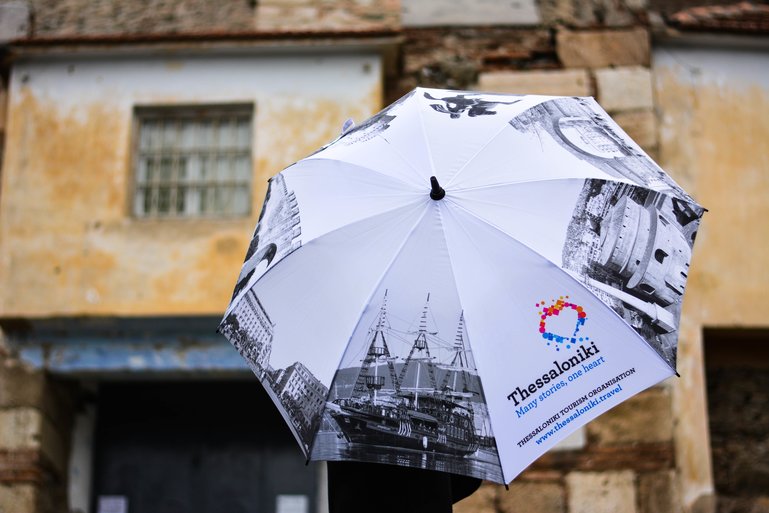
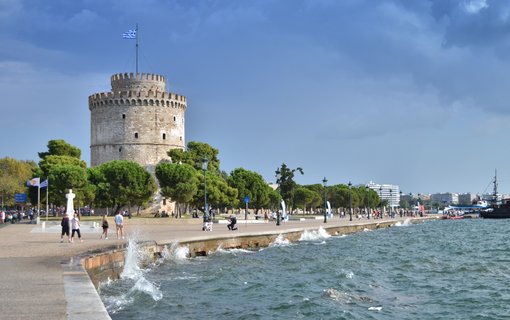
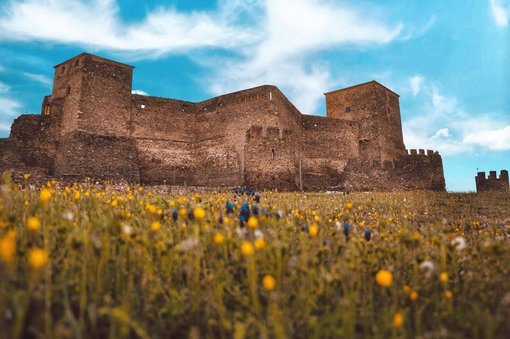
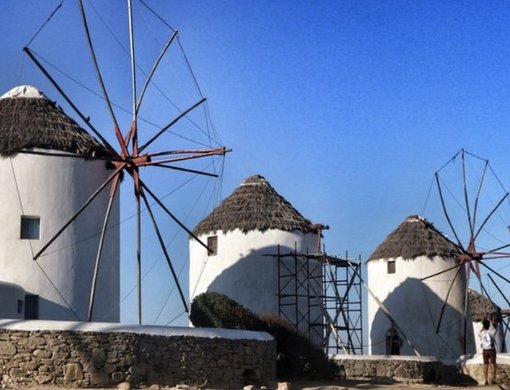
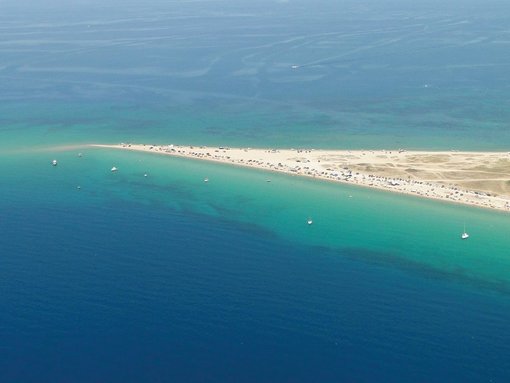
Mandy
Jan 10, 2020 at 11:59
Are all these churches still used for masses? I wouldn't want to disturb if they are. Where can I find the schedule for visiting them? Thanks